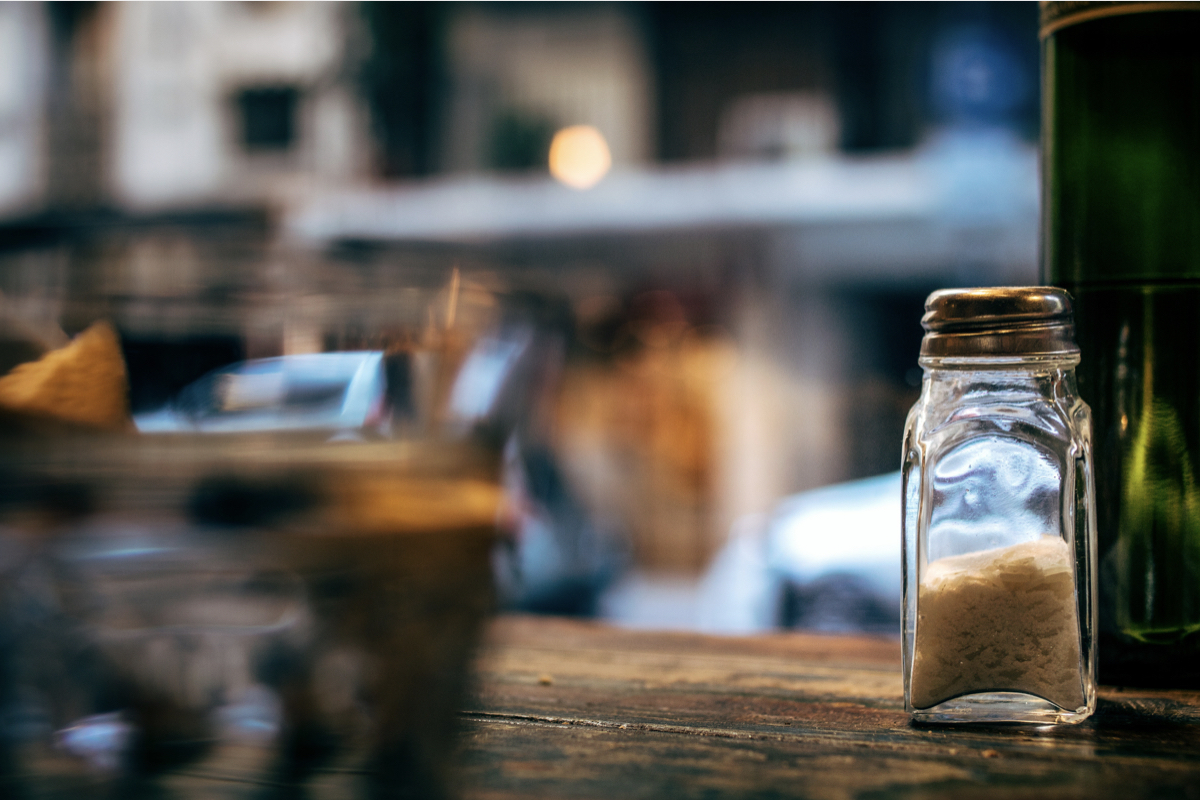Public health messages have consistently advised us to cut down on our salt intake. But people can often feel confused about the reasons for this, and how to apply this advice in daily life. This article aims to clear up this confusion, and provide practical tips for reducing salt intake.
Why Our Body Needs Some Salt
Table salt is made up of two minerals: sodium and chlorine (which forms the chemical compound ‘sodium chloride’ or ‘NaCl’). These are electrolytes which our body needs in order to function properly.
They play an important role in (1, 2, 3):
- Balancing the amount of fluid in our body
- Balancing pH levels
- Transporting and absorbing nutrients
- Muscle contraction and relaxation
- Nerve signalling
This may be part of the reason why humans have developed a taste preference for moderately salty food (4).
In some cases, additional electrolytes are needed to help with rehydration after illness or intense physical activity. For example, a sports drink that contains electrolytes boosts hydration after more than an hour of vigorous exercise (5). A homemade version can be made by: adding a large pinch of salt to 1 litre of diluted squash (5).
Therefore, salt contains electrolytes which are essential for human health. We usually only need this in very small amounts, but there are cases when a bit of extra salt can help to improve hydration.
Why Consuming Too Much Salt is Risky
A high intake of salt can increase blood pressure, which may increase the risk of heart disease and stroke.
A Cochrane review (which is a high quality summary of evidence) of studies which lasted at least 4 weeks tested the longer term impact of salt reduction (6). This review found good evidence that reducing salt intake helps to reduce blood pressure levels. It also found that a greater reduction in salt intake results in a the greater reduction in systolic blood pressure (the top number of a blood pressure reading). Therefore the authors concluded that reducing salt intake to 5-6 g per day “will have a major effect on blood pressure… [but] a further reduction to 3 g per day will have a greater effect and should become the long term target for population salt intake”.
However, we don’t have strong evidence which shows that this reduction in blood pressure (related to reducing salt) directly reduces the risk of heart disease, stroke or death related to these diseases (7). Some people argue that restricting salt may cause harm by increasing the levels of: certain hormones (plasma renin, aldosterone and noradrenaline), cholesterol and triglycerides. The evidence is mixed about this, but overall no clear risk has been identified related to reducing our salt intake from current levels (7, 8).
Beyond heart heart, a higher intake of salt is linked with:
- A higher risk of stomach cancer (9, 10)
- Higher calcium losses in our urine (but reducing salt intake hasn’t been seen to significantly impact bone health) (11, 12)
- A higher risk of developing kidney stones (13, 14)
It is also very important that babies don’t consume too much salt, because their kidneys aren’t able to cope with this (15). Those who suffer from oedema (carrying excess water – often in the feet, ankles and legs) may also need to reduce their salt intake as part of an overall strategy to reduce this swelling.
So there are a number of health reason to avoid consuming too much salt on a regular basis.
What About Different Types of Salt?
Regular salt or ‘table salt’ – this is the most commonly consumed type of salt. 97 – 99% of table salt is sodium chloride, and the remainder is usually an anti-caking agent (16).
Sea salt and Celtic sea salt is often coarser in texture than table salt. These also contain small amounts of other chemical salts such as: iron, magnesium, calcium, potassium, and zinc. But the majority of sea salt is still sodium chloride, and the minerals present are unlikely to confer a nutritional benefit – especially in comparison to the high sodium content. Sea salt may also contain small amounts of micro-plastics, although there is no strong evidence that this poses a health risk (17).
Pink Himalayan salt comes from a mine in Pakistan. It is similar to sea salt as it mainly consists of sodium chloride, but it also contains minerals, including iron oxide which is thought to give it it’s rusty-pink colour. There are numerous health claims related to this type of salt, however there is no evidence to back this up. In fact in 2014 the US Food and Drug Association (FDA) sent an official warning letter to a company who illegally claimed that Himalayan salt capsules could: improve blood pressure regulation, diabetes, asthma, lyme disease and “kill off” bacteria (18). There are also concerns that pink Himalayan salt may contain toxic chemicals such as: mercury, arsenic and lead (19).
Iodised salt is regular salt which has been fortified with iodine. Switching to iodised salt can boost iodine intake, especially for those who avoid or limit their intake of dairy and fish (as these are major dietary sources of iodine). However, this type of salt is not readily available in the UK and Ireland.
Low sodium salt is often marketed as a healthier alternative to table salt. These contain about 50 – 70% potassium, 30 – 50% sodium chloride and a small amount of anti-caking agents. These can support a slight reduction in sodium intake for some people. However, the high potassium content can be harmful for those with kidney disease, and may interfere with certain medication (so speak to your doctor if in doubt) (20). And it is usually a better idea to get out of the habit of adding salt to food altogether, as there is a still a risk of consuming too much sodium by using products such as this.
No studies have directly compared each of these types of salt. However based on their nutritional content, iodised salt and low sodium salt can be useful in some circumstances. Sea salt and pink Himalayan salt contain usually contain small amounts of minerals, but this is unlikely to benefit our health, and these may also contain harmful substances. Overall, there isn’t much of difference between the various types of salt, and none of these should be consumed in high amounts.
How Much Salt Should We Be Having?
The UK daily recommended salt limits based on age-group are (15):
- Up to 1 year old: less than 1g of salt per day (0.4g sodium)
- 1 to 3 years old: 2g of salt a day (0.8g sodium)
- 4 to 6 years old: 3g of salt a day (1.2g sodium)
- 7 to 10 years old: 5g of salt a day (2g sodium)
- 11 years old and over: 6g of salt a day (2.4g sodium)
The recommended 6g limit for adults works out as roughly one teaspoon of salt per day. However, this includes all salt in our diet, not just the salt that we add to food ourselves – and salt is found in many types of processed food.
The National Institute of Clinical Excellence have advised that this 6g limit is further reduced to 3g per day by 2025 (21). These cutoffs are based on evidence that restricting sodium intake to 1.2 to 2.4 g per day can help to reduce the risk of developing high blood pressure, and subsequent heart disease (6, 22).
Data from 2014 found that the average in of salt among UK adults was 8g per day (23). Although this had deceased by 0.8g per day since 2005, it is still well above the recommended level. Therefore, salt reduction remains a public health issue in the UK.
Practical Tips For Reducing Your Salt Intake
According to the most recent National Diet and Nutrition Survey (NDNS), the main sources of salt in the UK diet come from cereal and meat products (24). So it is important to to check the labels of packaged food in order to choose lower salt options. This can be achieved by choosing foods which have mainly green or amber traffic light labels for salt, or choosing foods which have less that 1.5g of salt (or 0.6g of sodium) per 100g on the back of the packet. This guide from the British Heart Foundation is a great help for making sense of food labels.
Because most people get more than enough salt from the foods they eat, it is usually important to avoid adding salt to our food. A pinch of salt can be used when cooking, but it is better to use other flavourings where possible, such as: pepper, herbs, spices, garlic, onion and lemon juice.
However, there are a set of government salt targets in place which aim to reduce salt consumption by setting limits for the salt content of 76 types of supermarket-bought food, and 11 types of food from restaurants or cafes. For example, the target for sausages is a maximum level of 1.38g salt (550mg sodium). See here for the full guidelines.
But it is still important to be aware of the types of food which are usually high in salt, such as (1, 22):
- Crisps and salted popcorn
- Salted nuts, pretzels and crackers
- Stock cubes
- Gravy granules
- Ketchup and mayonnaise
- Certain ready-made sauces and salad dressings
- Soy sauce
- Pickled food
- Yeast extract
- Cheese
- Processed meat e.g. bacon, sausages and salami
- Smoked meat and fish
- Powdered soup
- Some types of bread and breakfast cereals (check the labels!)
Ready meals, more highly processed foods and food from restaurants and takeaways are often high in salt as well.
So there are plenty of steps that we can take to reduce our salt intake. For more information on reducing your salt intake you can check out this infographic from NHS Choices.
Source: https://thefoodmedic.co.uk/2018/12/salt-health/


